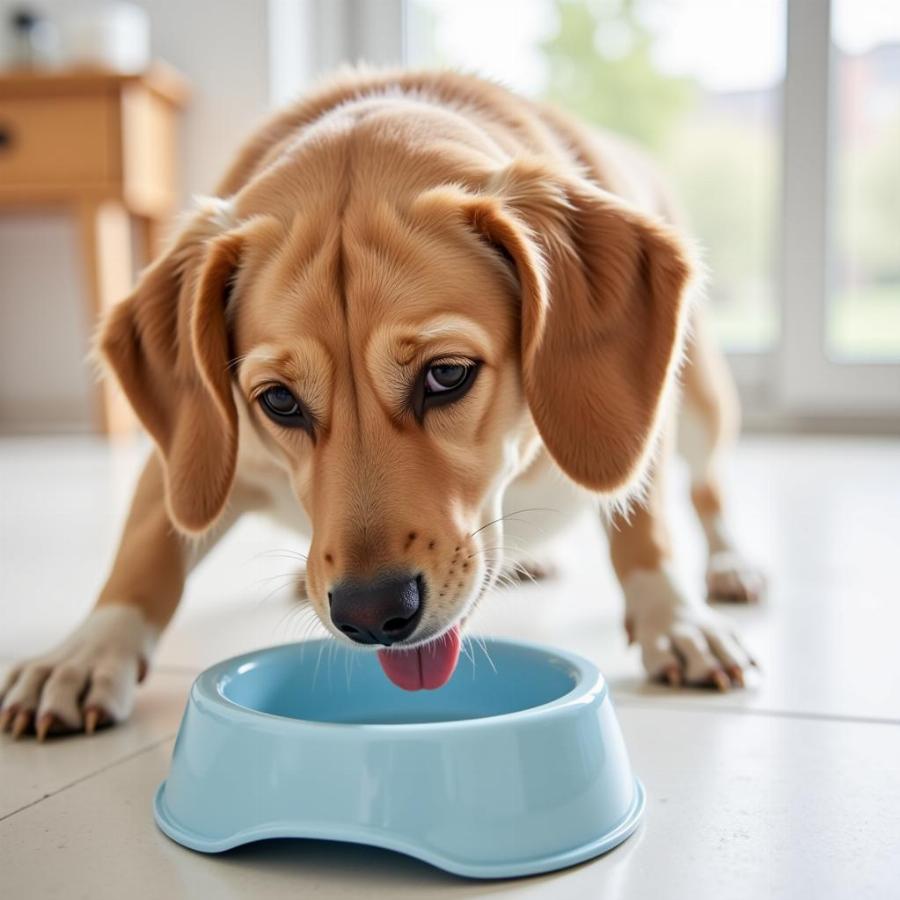Yellow dog pee is typically considered normal. However, variations in shade can indicate underlying health issues. This article dives into the reasons behind yellow dog urine, what different shades mean, and when it’s time to seek veterinary attention. We’ll cover everything from hydration to potential infections, giving you the knowledge to keep your furry friend healthy.
Decoding the Shades of Yellow in Dog Urine
Understanding the color of your dog’s pee can provide valuable insights into their health. While light yellow dog pee is usually a sign of good hydration, darker shades can signal potential problems. Let’s explore the spectrum of yellow and what each shade might indicate.
Light Yellow Dog Pee: The Ideal Hue
Light yellow urine is often the gold standard (pun intended!), indicating a well-hydrated dog. This is the color you want to see most often. If your dog’s pee is consistently this color, it’s a good sign that their kidneys are functioning properly and they’re getting enough water.
Dark Yellow Dog Pee: A Sign of Dehydration?
Darker yellow dog pee can be a sign of dehydration. Just like in humans, when a dog isn’t drinking enough water, their urine becomes more concentrated, resulting in a deeper yellow color. If you notice your dog’s urine is consistently dark yellow, encourage them to drink more water and monitor their intake.
Other Shades of Yellow: When to Consult a Vet
While variations in yellow are often related to hydration, other shades can indicate more serious issues. For example, very dark yellow or orange-tinged urine can sometimes be a sign of liver problems. Similarly, cloudy or murky yellow urine could suggest a urinary tract infection. If you notice any unusual shades of yellow, it’s always best to consult your veterinarian.
What Causes Changes in Dog Pee Color?
Several factors can influence the color of your dog’s urine, including:
- Hydration: The most common reason for changes in urine color is hydration. Dehydration leads to concentrated, dark yellow urine, while adequate hydration results in light yellow urine.
- Diet: Certain foods and supplements can affect urine color. For example, foods high in beta-carotene can sometimes cause a more orange tint.
- Medications: Some medications can also alter urine color. If your dog is on any medication, check the potential side effects or consult your veterinarian.
- Underlying Medical Conditions: As mentioned earlier, liver problems, urinary tract infections, and other medical conditions can also change urine color.
When is Yellow Dog Pee a Cause for Concern?
While yellow is typically normal, certain accompanying symptoms warrant a veterinary visit. These include:
- Straining to urinate: This can be a sign of a urinary blockage or infection.
- Frequent urination: Increased urination can indicate a urinary tract infection or other health problems.
- Blood in the urine: Blood in the urine is always a cause for concern and requires immediate veterinary attention.
- Lethargy or loss of appetite: These symptoms, combined with changes in urine color, can suggest a more serious underlying issue.
 Dog drinking water from a bowl: Maintaining proper hydration
Dog drinking water from a bowl: Maintaining proper hydration
How to Keep Your Dog’s Urine Healthy
Maintaining your dog’s urinary health is crucial for their overall well-being. Here are some tips:
- Provide fresh water at all times: Ensure your dog always has access to clean, fresh water.
- Encourage regular potty breaks: Take your dog out for frequent potty breaks to prevent their urine from becoming too concentrated.
- Feed a balanced diet: A healthy diet contributes to overall health, including urinary health.
- Monitor urine color and frequency: Keep an eye on your dog’s urine and consult your veterinarian if you notice any changes.
Conclusion
Understanding what’s normal and what’s not when it comes to dog pee yellow is essential for responsible pet ownership. By monitoring your dog’s urine and being aware of potential warning signs, you can help ensure their urinary health and overall well-being. Remember, when in doubt, consult your veterinarian.
FAQ
- Is dark yellow dog pee always a sign of dehydration? While dehydration is a common cause, dark yellow urine can also be caused by other factors like diet or underlying medical conditions.
- What should I do if my dog’s pee is orange? Orange urine can sometimes indicate liver problems. It’s best to consult your veterinarian if you notice this color change.
- How can I encourage my dog to drink more water? Try adding flavor to their water with a bit of low-sodium chicken broth or using a pet water fountain.
Related Articles on Beaut Dogs
Beaut Dogs is your one-stop resource for all things dog-related. We provide expert advice and reliable information to help you care for your canine companion. For further assistance, please contact us via Email at [email protected] for detailed and accurate answers.